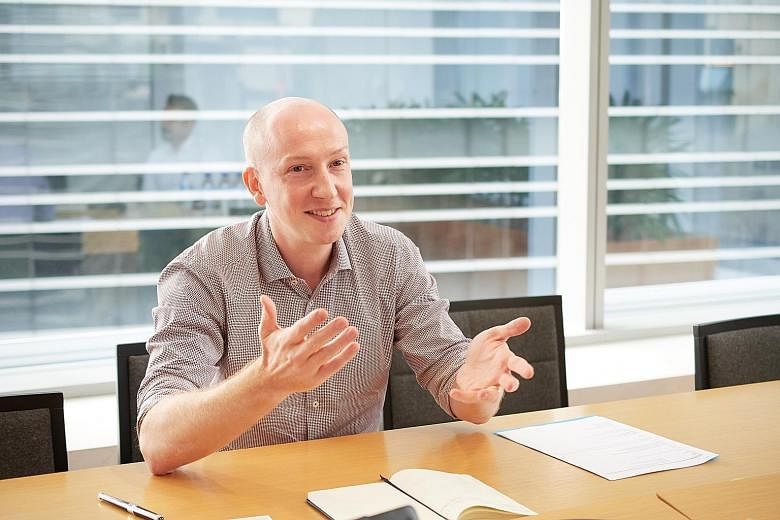You are 40 years old and you walk into a room full of ministers and top bureaucrats with a pitch that you have the best solutions for their urban mass transportation requirements. Do you have trouble being taken seriously since, after all, Asia is a region where age is accorded a certain reverence?
Mr Jean-Francois Beaudoin, head of Asia-Pacific for French giant multinational Alstom, is momentarily nonplussed by the question. Then, the Frenchman breaks into boyish laughter.
"It is always a bit of a shock for them the first time," he admits. "I can't do much about that except wait to be a bit older. But what makes you an impactful business leader is relevance, not number of years. At the end of the day, the perception gap has not affected any of my business relations. As long as you are clear and relevant and do what you promise, then people trust you."
France's Alstom, maker of the superfast TGV, is a global leader in urban mass transportation, manufacturing both metro rail and intercity train systems. It is a dominance that will be further cemented if the deal to combine with the mobility business of German giant Siemens, signed in September, goes through. Asia-Pacific, which Mr Beaudoin heads, currently brings in about 12 per cent of the global business, a figure that is poised to rise significantly, thanks to the relentless urbanisation across the region. It is Mr Beaudoin's responsibility to drive that growth for his company.
"If you have more than one million people in a city, it becomes relevant to have at least one metro line," he says. "The number of cities in Asia with more than a million people is in the hundreds. The need for high-capacity transport infrastructure is absolutely massive. Every year, 15 to 25 new metro lines open in China. India has accelerated over the last four years and every year one or two new lines open."
Along with China and South Korea, Alstom has had a Singapore presence since the early 1990s, starting with the North-East Line, which opened in 2003 and for which the company provided both the trains and signalling systems. A fully automated heavy rail line, it was in some ways a first for both Singapore and Alstom.
The Singapore journey continued with the Circle Line, for which Alstom provided the electromechanical system, and the company is also involved with the Thomson-East Coast Line. His company, he says, has grown with Singapore in so many ways.

Naturally, that begs the question: What's going wrong with our MRT system?
"Contrary to what you read and what people think, the Singapore MRT system is one of the best in the world," says Mr Beaudoin without a trace of defensiveness. "It usually places between third and fifth in the world after Hong Kong and Taipei, and perhaps Los Angeles. That's when measured by availability and number of disruptions reported versus passengers carried."
The perception of a high failure rate, he says, is because the level of expectation is high and passengers' tolerance of disruption low. In places where there are weekly or daily disruptions, like London, it becomes a non-event. While you could always improve, a zero-failure system does not exist.
Meanwhile, new systems being introduced to the rail network, such as predictive maintenance and remote condition monitoring, will further improve efficiency. Singapore's Land Transport Authority, he says, is keen to deploy these emerging systems on its network.
-
Fast facts
THE EXECUTIVE
Mr Jean-Francois Beaudoin, 40, is senior vice-president, Asia-Pacific, for Alstom. He was earlier chief financial officer and executive assistant to Alstom's chief operating officer. He joined Alstom in 2008 from car company PSA Peugeot Citroen. He has a PhD in mathematics and automatics from Ecole Nationale Superieure des Mines de Paris and an executive MBA from Insead, also in France. Married to a Bulgarian, he is the father of an eight-year-old boy and a four-year-old girl.
THE COMPANY
Alstom is a French multinational company operating worldwide in rail transport markets, active in the fields of passenger transportation, signalling and locomotives, with products including the TGV and Eurostar.
The company recorded sales of €7.3 billion (S$11.6 billion) and booked €10 billion of orders in the 2016-17 fiscal year.
Headquartered in France, Alstom is present in over 60 countries and employs 32,800 people.
That takes me to the other question that Singaporeans are curious about: the high-speed rail (HSR) link to Kuala Lumpur. What progress is he seeing, from an industry perspective? How committed are the two sides to see it up and ready?
Mr Beaudoin says he has noticed a rapid acceleration of the process over the past few months. While the project is yet to cross the point of no return, as he puts it, there seems to be a strong focus from both parties.
"There has been an unexpected level of work to put together a bid with the right level of details to get international bidders to participate," he says. "The project has become very much likely now and we are expecting a tender for the technical part to be announced in the next few weeks. Once that is out, we will decide how to position ourselves."
Should it choose to bid, Alstom would be a strong suitor because of its deep experience with cross-border train systems, particularly in Europe. But several issues would need to be addressed, not least of it technical standards. Countries tend to have national standards from the power supply tension to operating standards and even the width of tunnels and trains will have to be built to specifications that cater to both sides of the border.
"For the Paris to Netherlands route crossing Germany and Belgium, we have seven different signalling systems on board," he says. "But that was built for a Europe that was yet to integrate so much. Here, since the project would have been thought through, I would not anticipate much difficulty."
Still, there could be issues of sovereignty and who has responsibility for, say, an unexpected event, when the train is in Malaysian territory or in Singapore. Given Europe's integration, that is less of a problem but with the HSR, that is an issue that the two sides will need to address.
Alstom recorded sales of €7.3 billion (S$11.6 billion) and booked €10 billion of orders in the 2016-17 fiscal year. One massive connectivity project the world is eyeing for potential contracts is Chinese President Xi Jinping's Belt and Road Initiative (BRI), better known as the One Belt One Road project. That is, of course, if China is willing to share the pie rather than keep all of it for its own companies.
Mr Beaudoin points out that beyond the vision that has been put forth, specifics are in short supply. Some projects seem to have been included in BRI as an afterthought.
"For us to participate, there will need to be a global call for tenders," he says. "For BRI, we don't see those tenders except for small bits here and there. A lot of these could be government-to-government initiatives, which, by definition, exclude international competition."
It is India that he sees as Alstom's hottest current prospect in Asia. India, he says, is "railway country", where people do not hesitate to travel 24 hours or more by train. Its mainline, or intercity train network, is the third-largest in the world and No. 1 in terms of passengers carried. Alstom has a huge chunk of the country's rail modernisation activity and that takes Mr Beaudoin there a lot.
"Of the 5,000 Alstom staff in Asia-Pacific, fully 3,000 are in India," he says. "Alstom's largest engineering centre is in Bangalore with 2,000 engineers. We are making India one of the largest delivery hubs for the rest of the world."
With some 40 to 50 cities planning metro lines, the Indian wave is just starting, he believes, and Alstom is well positioned to capture it. It has three manufacturing centres in the country. The largest one, a €3.5 billion joint venture with Indian Railways to make heavy locomotives, is in Bihar state and was opened in the shortest time in the history of Alstom.
Starting out with automaker Peugeot Citroen after earning a PhD in maths and automation, Mr Beaudoin saw his career accelerate after he joined Alstom where, for a while, he was executive assistant to the chief operating officer, a position that clearly gave him a helicopter view of the sprawling company. He was sent to Asia four years ago, and has held his current position for a year.
Among his priorities as the top regional executive is to promote diversity, one of the five pillars of strategy laid down by its management in 2014. The goal is to have half the Alstom staff to be from outside Europe and for a quarter of the workforce to be women. On the first, Alstom is not doing badly; it has 42 nationalities on its Asia rolls. As for the second, it is work in progress. At the moment, just about 18 per cent are women.
"China does well on that score," he says. "Thirty per cent of our staff there are women and so is our business leader for the territory, who is Chinese. I want to set the tone from the top: Six of the 10 people in my management team are women, including the heads of human resources, legal and finance. They include Singaporeans, South Koreans and Indians."
Married to a Bulgarian, the Beaudoins have children aged eight and four. As a parent, he enjoys the diversity the children are exposed to in Singapore. There are also cultural lessons to be learnt, even for himself, such as how to use humour. French humour, he notes, is closer to the Japanese in its subtlety. Indians and Australians also tend to enjoy a joke. In some other parts, it pays to be a little more watchful with your words.
Did the Beaudoins have any trouble settling in? Except for the weather, not a lot, apparently.
"It is very hot to live here and the body has to get used to it," he says. "And unlike Europe, the season is pretty much the same year-round."


